2015 Ram EcoDiesel, Toyota Tundra Comparison
Tim Esterdahl | Mar 02, 2015 | Comments 35
Type the word “diesel” into any Tundra fan site or forum and you will immediately get comments declaring you a fool or suggesting if Toyota doesn’t offer the engine, they will never buy another Tundra pickup. The diesel topic has exploded over the past few years and helping fan the flames is the 2015 Ram EcoDiesel. As the only half-ton diesel on the market, rival truck fans have seemingly put the truck on a pedestal to use for/against their diesel argument. What makes it so polarizing? The engine. Is it really that much better? Let’s take a closer look.
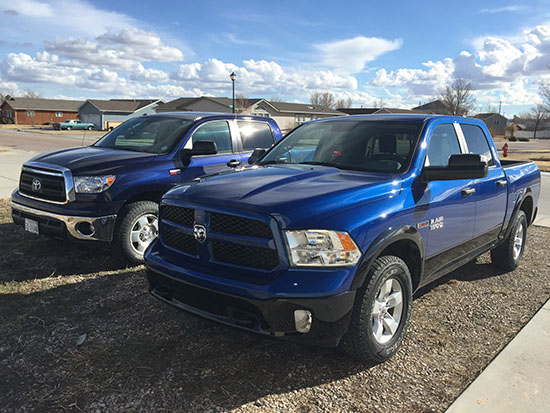
Both of these trucks look great to us and we would be happy taking either home.
VM Motori Engine
Any conversation on the 2015 Ram EcoDiesel has to start with the 3.0L diesel engine. The engine is an import from VM Motori out of Centro, Italy. This diesel has been in use throughout Europe for decades. We assume the U.S. version of the engine will be reliable since VM Motori has been producing engines for so long and with good results.
Also, an interesting side not is Fiat owns the engine maker. They bought 50 percent of the company’s stake in 2010 and completed buying the other half from GM in October, 2013. The story we have heard is that GM was going to use the 3.0L diesel engine in a next-gen Cadillac before the economy collapsed, they went bankrupt and then were forced to share their stake in the company.
Note: at the end of this story is a list of technical specifications on the engine.
When we opened the hood of the Ram 1500 EcoDiesel, it was at first surprising how small the engine really is. We had looked at this engine at various places over the past few years, but when it is sitting in your driveway and next to a 5.7L Toyota Tundra engine, it really grabs your attention.
With its small size, it is more tucked in than other engines, in our opinion. We wonder how many mechanics like to work on it since Ram trucks typically have a long front and, with the smaller engine, it is a bit hard to reach it. However, Ram engineers did help in this regard by making the belts easy to access from the bottom.
Driving Impressions
When comparing the two trucks, they basically measure up pretty even on the exterior looks. Also, usability is a bit mixed since the Ram offers their bedside boxes which certain truck owners will opt for a Ram because of it. However, judging both trucks straight up, with similar beds, it is all about taste. What makes a big difference then? Driving both trucks.
As most truck fans know, the 2015 Ram EcoDiesel is mated to a 8-speed transmission. This basically means you have a tiny engine with many gears. However, it is a diesel engine, so torque isn’t a problem and it is turbocharged. When driving the Ram, the EcoDiesel engine handles the weight flawlessly and shifting through the 8-speeds is smooth with just a slight feeling as it shifts. In fact, this shifting feeling can probably be chalked up to not being used to the 8-speeds.
On the flip side, the Toyota Tundra felt like it has a similar power output to the EcoDiesel and it produces more than enough power for the truck (the power output is technically very different). This engine mated to a 6-speed transmission is quite a bit different than the Ram. The shifting is more pronounced and the engine sounds like it is having to work harder. This isn’t to say it is maxed out by any means, you can just hear it more.
Also, the Ram completely bests the Tundra on ride quality. The air suspension and rear coil springs simply provide a smoother ride even compared to a 2014 model (note: I have a 2013).
Is the ride so much better that it would deter someone from buying a Tundra? It shouldn’t, but it is better.
Towing
This was an especially thorny issue during our testing. We had several loads lined up only to discover we needed a weight distributing hitch. Plus, we learned our Ram EcoDiesel has a maximum towing capacity of 8,560 lbs. The Crewmax Toyota Tundra has a towing capacity of 9,800 lbs. Also, the Ram EcoDiesel has a payload limit of 1,340 and our Tundra has a payload limit of 1,575.
Ultimately, no one in nearly 100 miles of us carried a weight distributing hitch. Also, we talked with all sorts of people who had never heard of one. More on this later.
This meant we really couldn’t tow with the truck. While yes, we could have towed 5,000 lbs (the maximum without a hitch), we assume the Ram EcoDiesel will handle this weight just fine. We know the Tundra does.
In the end, we came to the conclusion that even though this is a diesel engine, it isn’t necessarily a towing machine.
Fuel Economy
This almost goes without mention, but the 22 MPG combined from the Ram 1500 4WD Crew Cab is well above the 15 MPG from the Toyota Tundra. Yet, what does this really look like?
| 2015 Ram EcoDiesel 4WD Crew Cab | Toyota Tundra | |
|---|---|---|
| MPG | 22 combined (19/27 city/highway) | 15 combined (13/17 city/highway) |
| Miles/26 gallon tank | 572 | 390 |
| Fillups/12k mile year | 21 | 31 |
| Total gallons used/12k year | 546 | 806 |
| Fuel Prices* | $2.91 - diesel | $2.43 - gasoline |
| Annual Fuel Costs | $1588.86 | $1958.58 |
| Difference | $369.72 | |
| * according to AAA's national estimates http://fuelgaugereport.aaa.com/todays-gas-prices/ |
Note: the Ram Ecodiesel can achieve 29 MPG in a HFE model. Also, the 2WD achieves 28 MPG.
Yes, the fuel economy is quite a bit different, yet when you break it down to just $370 a year, it isn’t THAT much of a difference in our opinion.
Interior Impressions
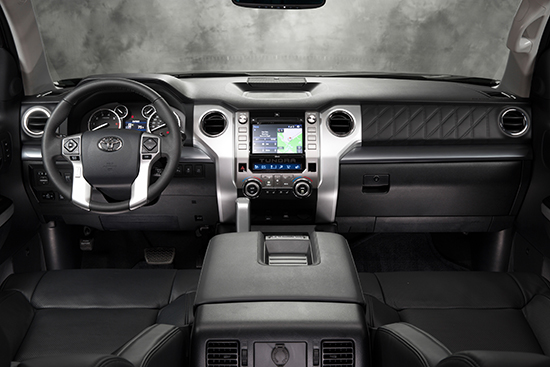
Here is a 2014 Toyota Tundra Platinum interior.
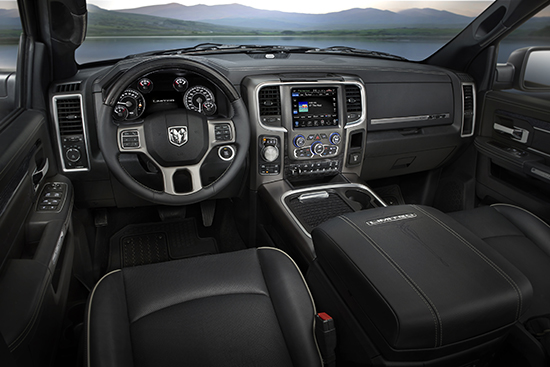
Here is a 2015 Ram 1500 Laramie Limited interior for comparison (note: we are terrible at taking interior photos like this!)
Another area where there are differences is in the interior. Officially, we had a 2015 Ram 1500 EcoDiesel Outdoorsman Crew cab with a sticker price of around $50k. It had a 3.92 rear end as well.
While my truck isn’t the same trim level as the Outdoorsman, I’ve been in plenty of time in Limited Toyota Tundra pickups which are closer. The difficulty here is Ram has 11 different trim levels and Toyota has 6 for the Tundra if you count the work truck. Doing an apples to apples comparison here is hard. There are three things that do stand out as differences between the two trucks:
1. Storage – the Ram has much more storage options than the Tundra. They did it right with the rear underseat storage option and the center console. With Toyota reducing the amount of storage options with the 2014 model, the difference is night and day. The Ram simply offers more and better storage.

Hello Tundra Engineers. This is how you do under seat storage!

Oh look, even more storage.
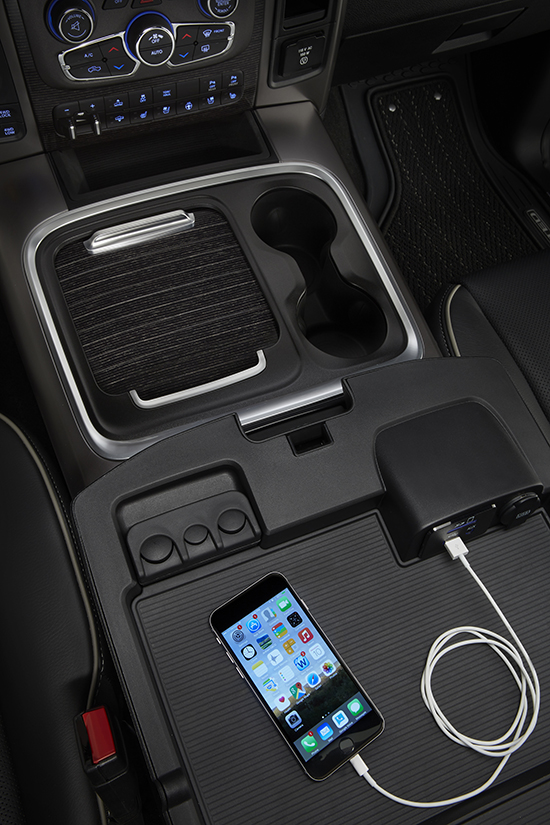
This is the center console. It has a split top. So, you can charge your cell phone or put things on the top shelf and then open it further to expose a larger space below.
2. Rotary Shifter – over the course of the last year, I have spent driven 4 different Ram 1500 trucks at various events and during this three-day loan. In each of these cases, they had the rotary shifter as opposed to the console shifter (plus, I have driven a slew of FCA cars and SUVs with the shifter). Ram reps have told me it takes about a week to get used and while I agree with their thoughts, I still don’t like it. Why? I recently drove a Ram 1500 in Montreal, Quebec, Canada and it hit me. It simply feels “less manly.” Again, this is a personal opinion and take it for what you will. Yet, there is something less fun about turning a dial to get your truck moving instead of grabbing the shifter and manually moving it into gear.
3. Uconnect System – Toyota fans can like it or not, but the Ram (and FCA) Uconnect system is simply the best on the market. Yes, the best on the OVERALL market. I’ve driven and tested out the Toyota Entune, Lexus Enform, Chevy MyLink and Ford’s My Ford Touch (they have now switched) and the Uconnect system simply bests them all. The easy of use, the bright icons and the many options are simply tough to beat.
The winner is…
This is a really tough question between these two trucks. On the one hand, the Ram 1500 bests the Toyota Tundra on most items like fuel economy, interior storage and driving. Also, like we said in the video, the price difference between comparable models is about $3k. Looking at a monthly payment difference of around $80 more for the Ram (depends on credit, interest, etc…) combined with the annual fuel savings and the price difference is within a few hundred dollars depending on driving habits. In our case, it works out to be $600 more for the Ram (monthly payments – fuel savings).
Now, we could add in the expected higher maintenance costs with diesel and the expected higher resale value with the Ram. This would add to the price confusion and really doesn’t settle anything.
In the end, we know the price difference is really not much either way. Sure, a dollar is a dollar, but when you are talking about a $50k truck, a difference of a few hundred dollars seems minimal.
Based on all of this, which one should you buy? We really don’t know. Honestly, we don’t. We like the features of the Ram 1500, great ride and the better fuel economy, yet reliability continues to be a thorny issue for them. Also, the knobs are great and all, but we still like a truck. This is what you get with the Tundra. It is a truck with minimal things to break and less things that can go wrong. Yet, we like them both.
What do you think? What did we miss?
For the gear heads, here are some statistics from Diesel Power Magazine:
- DISPLACEMENT: 3.0L (182 ci)
- CONFIGURATION: 60-degree, even-fire V-6
- ENGINE WEIGHT: 498 pounds
- BORE AND STROKE: 83 mm x 92 mm (3.26 in. x 3.62 in.)
- COMPRESSION RATIO: 16.5:1
- ENGINE BLOCK: Compacted-graphite iron (CGI) casting that weighs 159 pounds, featuring four 14mm head bolts per cylinder
- BEDPLATE: A one-piece, 35-pound assembly retains the crankshaft and ties the bottom of the block together with six 12mm bolts per main bearing
- CRANKSHAFT: Forged 4140 steel with 74mm (2.91 in.) main bearing journals and 67.5mm (2.66 in.) connecting rod journals, externally balanced
- CYLINDER HEAD: Aluminum castings with four valves per cylinder
- VALVETRAIN: Dual overhead camshafts (DOHC) with roller finger followers and hydraulic lash adjustment
- VALVE SIZE: 28.5mm (1.12 in.) intake, 25.4mm (1.00 in.) exhaust
- BASE POWER RATING: 221 to 268 hp at 4,000 rpm
- BASE TORQUE OUTPUT: 369 to 421 lb-ft at 2,000 rpm
- MAXIMUM ENGINE SPEED: 4,800 rpm
- FUEL SYSTEM: Bosch common-rail injection with a CP4.2 pump and CRIN 3.4 solenoid injectors capable of running up to 29,000 psi (2,000 bar) and seven injection events
- TURBOCHARGER: Electronically controlled variable geometry with water-cooled ball-bearing cartridge in high-power applications
Search terms people used to find this page:
- tundraheadquarters
Filed Under: Toyota Tundra Reviews and Comparisons

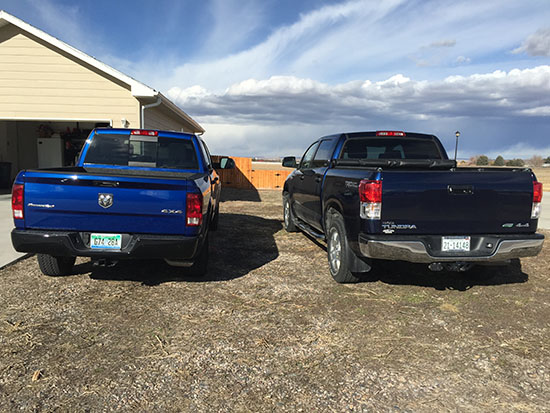



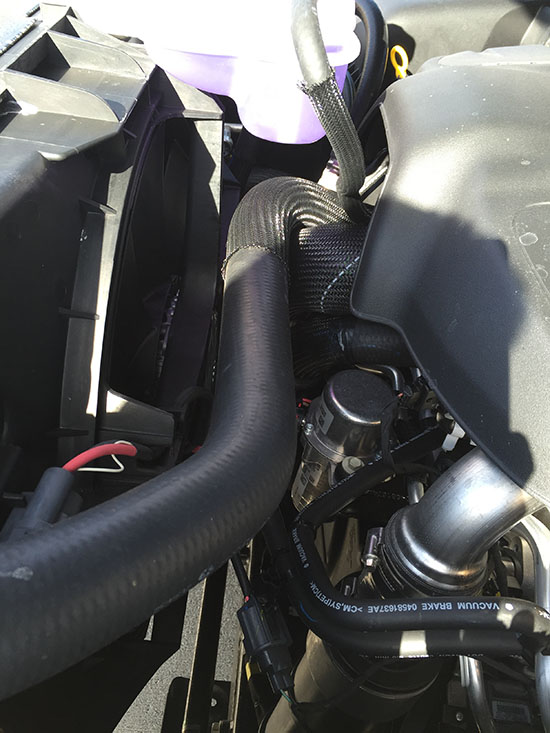




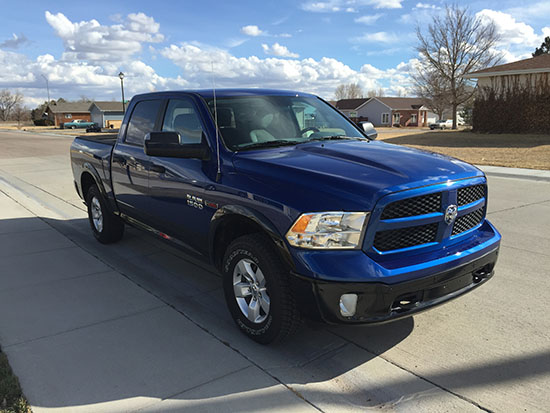



“On the flip side, the Toyota Tundra has a similar power output to the EcoDiesel”
um…..no.
Ya, what you said. Had Tim been able to tow with it, he would have noticed the difference in power output. It’s not about HP and lb-ft numbers, it’s about WHEN those maximums kick in.
The Tundra has the V8 giving maximum horses at 5,600 RPM and max torque at 3,600. By comparison, the Ram EcoDiesel brings both of those at a full 1,600 RPM lower. This means more low-end power and more pulling when starting a load or hauling it up a hill. Add in the extra couple of gears the Ram has and you’ll really notice a difference on the latter.
Aaron,
This is true and with a load, I probably would have noticed it. I’m just saying in everyday driving, during the time I had it, I didn’t notice much difference between the trucks.
Now, there are those who will notice a difference and I freely admit, the circumstances likely played a role. I had it during a snow storm and on icy roads, so I wasn’t paying particular attention to the power output all the time.
-Tim
On paper yeah, but I’m not so sure that is true in reality. The 2.7 F150 ecoboost with a six speed didn’t have a problem beating the ecoDiesel on Davis Dam:
https://www.youtube.com/watch?v=jB7cq7TK6UA
Check the RPM ranges on the EcoBoost. It’s a high-compression engine that operates very similarly to how a diesel engine does. Its torque ratings are higher than a similar engine without the higher compression and turbocharging.
That’s a totally worthless comparison. Wonder why they didn’t show the tach on that Ford in that test. It was probably at red line all the way. This is the kind of BS the truck industry is pushing. Try that nonsense every day in real production and that gas motor won’t last long.
You could put an Indy car motor in a truck too and then pull 25000 pounds up a 20 mile grade at 10,000 RPM it might make it to the top once or twice.
Comparing gas and diesel motors in this application is pointless. Every wonder why there are no gas motors in 18 wheelers? How about putting 10 2.7 Ecoboost motors in a locomotive then try and tell us how much sense that makes. Perhaps we could put a 15 liter cummins in a funny car then say how bad it is after it runs a quarter mile in 30 seconds.
Keep it real.
NO WAY NO HOW, there is zero possibility of that ecodiesel towing as well as the 5.7 Tundra. the 5.7 bests the HP by 60%! 141 hp more, and comparing rpm of torque, while VERY important 90% of the Tundra’s 401 lb. ft. are in by 2200 RPM besting the rest of the gas engines ( ford has never proven the ecoboost to put down max @2500 rpm) add to that the 141 hp difference and the Tundra will WALK AWAY from this truck with a load and I’m ready for someone to bring on a test to me if you think I’m wrong………..
All you did just now was prove you have no clue what towing is about. Horsepower has nothing to do with it. Ask any trucker. Better yet, I’ll just tell you since I was one.
My Kenworth T800 had 475 horsepower choked back to 425 with emissions and efficiency dampers. Yet I was pulling 44,000+. By horsepower, that truck was weak. By towing? Far and away better than your Tundra despite your having higher HP.
Towing is all about torque. Horsepower is all about bragging rights and how fast you can go.
You boys want to take this debate outside??
-Tim
Tim, this is the heart of the issue. Diesels don’t run the same way. People need to understand the difference between pulling torque an HP.
My cummins can have a 15000 pound load and pull it up any grade. All I need to do it apply a little turbo boost and it keeps on going. If I need to pass there is no way.
If people buy a Ram 3.0L diesel and expect it to behave the same as a 5.7L gas Tundra they will say it’s slow and underpowered. They need to drive a 20,000 pound truck with 10 speeds before the will ever understand why diesel behalves the way it does. Put a 15L gas motor in a 40,000 pound truck and it will get 1 MPG.
People don’t understand the issue. Well, Aaron does.
I’m very interested in your views and observations of the Ram 1500 diesel but not in the context of a gas tundra comparison.
Larry,
After the three days, it is clear this EcoDiesel is a “diesel” in name only. It isn’t meant to tow a lot. However, it also doesn’t suffer from turbo lag.
What is it? It is a MPG machine.
Comparing it to a HD diesel like a 6.7L is apples to oranges. It isn’t even close to the same throttle response or engine. Nor is it meant to do the same job. The HD is meant for towing. This EcoDiesel is good for 27 MPG highway (28 2wd, 29 in HFE).
Does that help?
-Tim
you have part of a story with what you are saying. the argument of HP vs. torque is definitely valid in considering pulling from a dead stop…… BUT, that’s part of the equation only. You also have to consider once a load is moving how fast it will gain speed which has EVERYTHING to do with Horsepower and lets not forget those powers (some engines are horrible until close to peak)at specific RPM and then there is gearing to boot.
Now, the next thing to consider after figuring out how much HP and Torque you have at a given RPM BUT also how well that point of power is matched to the gearing of the trans and rear diff ALSO considering the efficiency of the Torque Converter.
Here are the Facts.
Tundra is equipped with an Engine and trans that were designed from the beginning to work WITH each other exclusively along with one of the most efficient Variable lockup torque converters and equipped with a 4.30 rear diff. making 90% of 401 lb. ft. from 2200 to 5500 RPM its the flattest gas torque curve of the bunch.
Ram is equipped with a VM Motori diesel designed to work in various applications and a ZF 8 speed trans that was designed and with FCA is in a BUNCH of different vehicles all with different engines and weights etc. which means the DEFINITELY weren’t designed to work with each other so its efficiency is limited based on that alone. Question for you Aaron, why do you think no one has knocked the Duramax/Allison combo down in the diesel world when BOTH other offerings have more power? answer: they have many years and tunes under their belt to get them matched well……….. Every single diesel in that segment is at peak torque curve at 1600 RPM, at 765 the duramax should be CRUSHED by the ram at 865 lb. ft. and Ford’s 800 yet they still lose……..
Your KW means nothing in this conversation as you are talking about a Tractor with minimum 9 gears split with 2 axle ratios splitting them low high. BTW what was the Torque rating of your rig? I BET you don’t know…………… its funny you mention fast and bragging rights. 99 of Tractor drivers DONT KNOW THE TORQUE OUTPUT of their Detroit 60’s, big displacement Cummins, Cat diesels Etc. the point I’m making here is that once you pass a sufficient amount of torque 1200 plus lb. ft. for Tractors, Horsepower helps you accelerate the load down the road. RIGHT FROM KENWORTHS OWN T800 BROCHURE IT SAYS “The highest horsepower engines” now why on earth would they say that?
You picked the wrong guy to say I know nothin Aaron. But hey it was worth a shot, a lot people talk that don’t know much.
Yeehaa!
I meant to say it felt like it to me. Let me amend that part.
-Tim
Thanks for pointing out the storage comparisons between the two trucks, I hope Sweers is paying attention!
you and me both, there is no where to put anything in the new tundra, this is one area they have to sort out before I buy another one.
Tim,
Thanks again for a very real world, detailed, and unbiased comparison. I think you are the only automotive journalist that can do that!
Here is something you might be able to line up for towing requirements next time; particularly when people do not know what a load equalizer hitch is…and that is just hilarious.
There are many “wakeboard” boats that will weigh in the 6,000 to 8,500 lb. range. Most of these boat types have large V-8’s at the “back” for power. Usually the wheels are placed further back on the trailer because of this. One reason is to carry the “weight” and another to eliminate “sway”. But unlike most trailer set ups the hitch weight will often be only 5 to 7% of the total weight; not the normal 10 to 14%. This means you will be towing larger loads without the requirement of a load equalizer hitch. Something like a 23 LSV Malibu Wakesetter comes to mind. Depending on the trailer manufacture, the total load will be in excess of 8,000 lbs. but the hitch weight of about 500 lbs.
FWIW: Once the dealer got my JBL Entune fixed in our 2014 Tundra; both myself and my wife thoroughly enjoy it. It is by far the best infotainment system we have use and is now completely bug free. One of the most outstanding features is the free form English we are able to use for Navigation. I know the GM’s and Ford’s do not do that; but Ford claims they will have that feature in their trucks in about 18 months? I have not used the U Connect, so I do not know how it compares.
Thanks again for the real review. It is so refreshing not to have marketing hype.
Randy,
Thanks as always for the insightful comments. I’m glad you got the Entune system working and it is a really good system. I just find the Uconnect system better FWIW. However, that’s my opinion and you know what they say about them!
I’ll try to convince the wife we need to buy the boat for “testing purposes.” I’m sure the IRS would let me write it off!! Haha…
-Tim
Here are a few points that come to mind. Now keep in mind that I am a Sales Consultant at a Ford and Toyota dealership. I drive a Tundra, but like to think I am open minded enough to accept if something is better. Yes, I’m passionate about Toyota, but will certainly admit their faults too.
I would have to drive both to determine which I liked better, especially for towing/hauling. With that said, there is no way I would get the diesel Dodge/Ram. Here’s why…
I’m really surprised you mention “the expected higher resale value with the Ram.” I think that is the first time I have ever heard that, especially in comparison to a Toyota! Traditionally Dodge has been a bottom feeder in regards to resale value. Traditionally Toyota has been at the top with any of their SUVs or trucks. Having a Tacoma or a Tundra to trade is like having a Joker in your hand. You can pretty much do what you want with it.
As far as “better ride” goes, unloaded, sure. F-150 and the Dodge have a more “car-like ride”. Lets put a load or a trailer on that thing and see how it changes. I’ve done 4 test drive events with all the competing models, but I have not done one with the current gen Dodge. When you put weight in the box, or a trailer on the back, the Toyota is consistent in how it handles. It doesn’t feel any different from unloaded. The softer springs on both the Ford and the Dodge completely changed the handling.
As far as maintenance and reliability, do we really need to discuss this? Tundra has been named the “Most Reliable Truck” by J.D. Powers for what, 8 or 9 years now? I don’t think a Dodge is going to win that in any category of vehicle. I’ve never read a long term review or 3rd party source that wouldn’t agree with that. If somebody were to ask, “which is the most reliable auto brand in the _______ category,” I don’t think Dodge will ever be mentioned.
Typical oil change at my dealership, on a gas engine with regular semi-synthetic oil is $38, full synthetic is $57. With full synthetic you can go 10,000 miles between oil changes instead of 5,000 with semi-synthetic.
I just called the Dodge dealer across the street, oil change on the EcoDiesel is currently $154! The oil filter alone is $75. The service writer said you can do 10k miles between changes also.
I totally agree that Toyota struck out with the storage on the latest Tundra. I’ll keep my ’10 CrewMax, thank you very much. There is no under or behind the seat storage anymore. I’ve got a ton of stuff there! They did away with the 2 glove boxes. Ford did their back seat and flat load floor much better on the F-150. If you aren’t going to give me the option of a sliding and reclining back seat, you better give me some storage, and a flat floor instead of a pedestal that you can’t keep things on.
For my area, diesel is almost always $.70-.75 more per gallon than gas. I really don’t want to mess with the oily fuel pump handles and smell of diesel exhaust either. All diesel owners should use a fuel additive to add lubricity to the fuel since the feds took all the sulfur out. Figure another $3 per fill up to use part of a bottle per full tank. Cold weather needs anti-gel additive. Let’s figure an extra $3 per fill during the winter too.
I just put the TRD Supercharger on my truck last week, so now the power is more than I could ever max out. The motor was more than adequate before, but I wanted to be quicker when passing when I’m hauling. I only use my Tundra for towing~ a 27 foot bumper pull camper (8000 lbs+/-), a 2 place enclosed snowmobile trailer (3500 lbs+/-), a 24 foot wakeboard boat (6000 lbs+/-), or for hauling motocross bikes.
I haven’t had a lot of experience with the UConnect, but it does seem pretty good. I think Toyota could do better with their Entune, but it isn’t bad. I’m more used to the MyFordTouch system.
I have a few more specific areas to discuss, but will leave that for another time. I’d like to discuss braking and traction control, and interiors, but that’s enough for today.
The very last reason I would choose a Tundra over a Ram is that I refuse to pull my tow mirrors out if I don’t have a trailer behind me, and I absolutely HATE truck nuts!! I think they must give those away with every Dodge purchase??:)
Speedster
Speedster,
LOL. No truck nuts for you eh?!? Thanks for your comment. I would only point out I am saying the “expected higher resale value” in terms of the diesel. Ram or otherwise, diesels typically have a higher resale value across the board.
The towing and unloaded ride quality is a pretty interesting debate actually. If you look at the numbers around 50 percent of half-ton owners tow a vehicle. Look at that number closer and those customers tow, on average, a handful of times a year. Now, I agree the Tundra will hold a load more evenly in the bed when towing thanks to its frame and leaf springs, but what is more important to an owner – having a truck that handles well unloaded or loaded down? This is a debatable item.
Please chime in again on the brakes/traction control and interiors. I’m looking forward to all the viewpoints we can get.
-Tim
Tim,
Great article! You covered everything. Remember Toyota was going to offer a 5.0L V8 Cummins that should have gotten @550 ft. lbs. torque. That puts the Tundra up front, even with a 6spd.
You can’t beat a diesel for MPG and torque at low RPM and that 8spd helps the Ram’s smallish diesel over achieve. Hope Sweers is listening about the trans. I don’t like the way my trans shifts – it’s slow to downshift and holds higher gears too long.
My ’12’s interior is just dated and its Nav/head unit design is 10 yrs old. The new Tundra interior is better but I had hoped Toyota would have gone all out and made it a leader. Everyone who rides in my truck loves the ride and I do too. I felt the ’12 Ram wallowed in corners and dove when I braked. My Tundra is firm and handles better. To me its the tires that make a difference.
My TRD blower makes my Tundra feel like a diesel (4.88 gear – posi) they way it pulls off the line. The power comes on immediately. I get 16.7 combined and more for HWY. I’m keeping my rig – nothing beats it for power, braking and its awesome quicker steering. You sit up over the hood too & I like that position. I sit lower in the F-150 and the Ram.
-Rick
Thanks Rick! This story was so large, it was really hard to address all the different facets. I’m glad you found it informative.
-Tim
I will vouch for many of the viewpoints of what Speedster is talking about.
In addition to the nightmares never resolved by Ford with my F150 EcoBoost engine, the suspension was lame compared my Tundra. The F150 could not handle the payload in the bed as well as the Tundra, particularly the 4×2 F150s. My Ram friends tell me it is even a little less capable than the Fords in that department.
Many pickups today are becoming too car like, much less truck like, and much less truck capable.
Some of the newer trucks are so frail in this area they might as well be Ridgelines; that’s not a bad thing if that is what you really want, a car with a box.
Tim alluded to this in the Video, something to the effect; the Tundra is still a truck.
Great work Tim, I would not call myself a fanboy,but I have owned 2 Tacos and currently a 2008 Trd Sr5, and all of them have been dependable and resale value is unmatched. I will be looking to get a new truck down the road and would like to see Toyota offer some better options. Interior and Exterior. Thanks
Thanks for the comment Ron!
-Tim
Tim,
pretty clear which truck you liked better from reading the article. Same thing I thought when I shopped last time.
one thing people are forgetting in the power and acceleration etc, is the overall gearing is a different animal with the 8 speed ZF and the 3.92 rear. It has a major advantage over the tundra in this regard. For example, first gear is 4.71 x 3.92 for the Ram, tundra is WAY taller than that.
BB,
You won’t see a for sale sign on my truck anytime soon. 🙂
It is a different truck and they each have their pros and cons.
Good point on the gearing. It definitely feels different from 0-60 with the shifting. However, I didn’t notice a big power difference with the way I drove. Although, I will admit the icy roads and limited time in the truck influences my opinion.
-Tim
what about pricing? Can you get a crewcab dodge ram in the more base trim level and at what msrp pricing either 5.7L hemi or ecodiesel vs a DC or crewmax SR5 equipped tundra msrp?
I went onto ramtrucks website and the 2nd base level trim in a crewcab since I need the rear seat legroom and 6’4″ bed is 46K msrp vs. my DC SR5 tundra was 37K msrp. To me, apples to apples is way off unless the dodge ram has a HUGE say 8K rebate or something which I do not think it has right now. Even a crewmax SR5 tundra is under 40K msrp usually at most 2 grand more SR5 vs. SR5 comparison DC vs. crewmax tundra. Is there a 6K rebate on the dodge ram to make it as cheap to purchase as a Sr5 tundra?
MK,
It is really, really hard to do an apples to apples comparison since Ram offers nearly triple the trim level options that Toyota does. For me, the SR5 is more akin to the BigHorn or maybe even Outdoorsman trim level.
I contend that the price is a lot closer than people think. However, this was one search I did on Cars.com and everyone’s buying experiences will be different.
-Tim
I guess what I am trying to say is these 1/2 ton trucks are becoming priced out of my comfort level. I never in my wildest dreams thought I would spend over 30K on any new vehicle even a tundra/silverado. Now, in 2014 my tundra was 32K purchase price – OUCH! Still in my eyes the cheapest 1/2 ton truck to purchase, but unreal pricing and the mfgs. think a 3% raise per year is justified for like forever it has been that way. Mfgs. just think customers won’t notice it when they do 2-3 times per year a 1 to 1.5% price hike mid-season instead of one big 3% price hike in a new model year.
Another thing I found out on the ramtruck website is it is VERY hard to build one online has tons of options and trim levels to pick from vs. the tundra basically just a few is all.
Well after 18 months I still smell good!
No major problems yet with the Tundra!
http://www.wxyz.com/news/local.....-them-sick
Randy,
I saw that news item as well. I actually talked with a Ram engineer last week about it. It seems like a non-story with it affecting so few trucks and being a part issue.
My bigger question is with that story covering people living in Michigan: who the hell buys a 2WD truck in Michigan??? I lived there for 10 years and you couldn’t give me a 2WD truck. No way, no how.
-Tim
agree, no 2wd here in WI as well. I doubt I have EVER seen a 2wd tundra besides the basic trim level below the SR5 which is almost non existent.
I guess I will have to go into a dodge dealership and price out the outdoorsman or bighorn edition since was totally confused online on what to compare an SR5 to whether 5.7L hemi or diesel engine. I want a power seat, but NOT leather. buckets seats are nice but can live without them if needed to since the seats for passenger and driver are identical anyways. Most everything else I want (besides the darn power sliding rear window in the SR5 on tundra cannot get) is all I need and want.
I talked today for example with a lady who bought her 2014 hyundai santa fe msrp 41K fully loaded vs. my identical 2014 hyundai santa fe (same engine, both had pwr. drivers seat, pwr. heated seats but mine was cloth vs. her’s leather, same Long Wheel base, same backup camera, etc.) and my msrp was 32K. Try telling me leather seats with a/c built in, push button start, more sensors, GPS NAV, AWD vs. just FWD, basically is all difference is worth 9K more in price? NOT!
I just got back from some Ford F-150 training. The trainer there had all kinds of info on the Dodge Ecodiesel. He has the Dodge towing capacity at 7200 lbs, (with the optional 3.91 rear end) and the payload capacity at 998 lbs. Does that jive with what you found, Tim? You said yours had a tow capacity of 8560 and payload of 1340. Did you look in the manual to get that? I’m just curious. I suppose the trainer could have been using worst case scenario.
The biggest surprise was him quoting the Jan. 2015 issue of Motor Trend magazine as measuring the Ecodiesel 0-60mpg time of 8.8 seconds. Doesn’t a Prius go 0-60 about that fast?;)
Hey Speedster,
The numbers the trainer stated need to be qualified with what type of cab configuration, bed length and 2WD vs. 4WD. Towing capacities get pretty confusing because of all the variables.
Check out this chart: http://www.ramtrucks.com/asset.....charts.pdf
I matched my cab configuration, rear axle, 4WD and bed length to the chart to get my numbers.
Also, the EcoDiesel is slow by comparison to gas. A pretty stupid thing for the trainer to say though. Smart truck buyers aren’t buying a diesel to run quarter mile track times.
-Tim